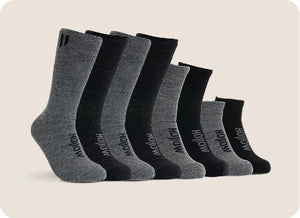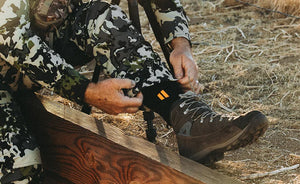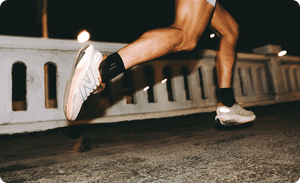Hiking Farther with Dry Feet
One of the biggest rookie mistakes that hiking beginners make is going on a hike with regular shoes. Some might switch them out with their running shoes, but they don’t always take the time to buy hiking footwear.
While hiking footwear, including moisture-wicking hiking socks, can be a bit expensive, they’re a worthwhile investment for you. These are not only durable but are also game-changers. With their help, you will be able to have a better hiking experience and be able to achieve your hiking goals with ease.
It’s not just about improving your hiking experience though. Investing in better quality hiking footwear also provides you with the following benefits:
Your Foot Health Matters
Specialized hiking footwear is actually better for the health of your feet. Many runners, athletes, and seasoned hikers know that their favorite activity can cause toenail problems, bacterial and fungal infections. Issues like athlete’s feet can be caused by moisture becoming trapped in your feet.
Moreover, even if you don’t have athlete’s foot, you can end up with itchy feet, smelly feet or even with painful blisters on your feet when you have the wrong socks and shoes for your chosen activity. If your feet are not in healthy condition, you can end up facing a lot of problems on your hike and beyond.
Protection From Injuries
With hiking, there’s always a chance of injury from falling stones, a misstep or even just stepping into a bramble bush that can cause issues. With the right shoes, you can make sure that such an accident does not cut your feet, crush your toes or cause an injury that could put your hike at a stop. So, start by picking a really great, durable shoe purpose built for hiking.
Having strong and durable shoes will ensure that you can go on rough terrain without facing any injuries. Poor shoes not only wear away on such trails but they also tend to offer poor protection. It’s a good idea to invest in good hiking shoes so that you can continue on your trails without any issues.
Support and Stabilize Your Feet
Foot injuries are the most common type of injuries you can experience when you are hiking. The uneven terrain and different textures all contribute to causing foot injuries. One wrong step on a hike can be disastrous, which is why you need the right footwear.
For some unfortunately uncoordinated people, it is possible to twist their ankle even when they are walking on a straight path. However, with the right shoes, you can reduce the chances of this happening. A little compression throughout your socks can help when hiking too. That light compression, like offered in Hollow Crew Socks, will provide improved blood flow and keep your feet in better shape all day long.
Comfortable for Prolonged Footwear
It’s a given that when you’re hiking or trekking, you will need to wear your shoes for a long time. You need to make sure that they’re comfortable. Otherwise, the hours of trekking can cause issues. Even with the best socks for hiking boots on, if you do not have comfortable shoes, your feet will suffer.
Chaffing of the skin can result in blisters, and in some cases, your shoes might even skin the blisters further, causing deeper injuries. When your footwear is comfortable, you can hike for miles without facing any discomfort other than the general fatigue that a large hike might bring.
You can see that all the reasons highlighted here emphasize just why you need to invest in your hiking footwear, including your socks. Also, be sure you have worn and tested those shoes prior to the huge hike you might be planning along with AT or something of it's kind.
Picking the Right Hiking Shoes for You
Now, investing your footwear doesn’t just mean that you spend more money on it. We also mean that you take the time to properly research your options to find the best shoes and socks for you.
When you’re looking for the right hiking shoes for you, we think that you should focus on the following factors before making a purchase:
Look for the Perfect Fit
In this case, you want to make sure that the shoe fits your feet properly. It doesn’t mean that you just focus on the shoe size. This is only the measurement you get from the heel to the toe. In many countries, shoe size is standardized, and many people have feet that meet these standards.
However, you should consider the following measurements as well:
- The length of your arch – This determines how your foot will sit inside a shoe and directly affects the functionality of the shoe.
- Width of your foot – This relates to how wide your foot is from end (the ball of the foot). It can differ for people so pay attention to this area.
- The volume of your foot – This is measured as the thickness of the feet, particularly, how much room your feet occupy in a shoe.
Given these measurements, you can see that certain shoes might fit you better while others do not. The subjectivity of the fit can make it difficult, but if you focus on the length, width, and volume, you can find a shoe that fits you like a glove.
Pay attention to Traction
Traction of the shoe refers to the grip. For terrain, this is extremely important as traction prevents slips and falls when the terrain is grainy, slippery and rough. Some shoes do not have soles with good traction and can lead to accidents in the trail.
Traction can be measured by focusing on the tread as well as the material used for the outer sole of the shoe. It’s also the reason why many companies advertise their unique tread patterns. Some are capable of giving superior traction but remember that the tread always wears down.
Much like with tires, if the tread on your shoes becomes smooth, you will slip and experience issues in hiking when on rough or slippery terrain.
Breathability of the Shoe
This relates to how much airflow the shoe allows. As a general rule, lightweight hiking shoes are more breathable, even with socks on. Lack of ventilation can cause skin problems, including rashes, blisters or even infections.
The breathability of the shoe is important since, when paired with moisture-wicking hiking socks (perhaps made from alpaca), these shoes can ensure that sweat or moisture does not collect in your feet. This factor improves your foot health greatly.
Durability of the Shoe
This relates to how well the shoe lasts in the terrain it is exposed to. As a general rule, shoes made from synthetic materials do tend to wear out more easily as compared to leather boots. However, based on the terrain and the environmental factors, some shoes made from synthetic material can last you for years as well.
The durability of the shoe should also be considered for wet environments where water exposure can be an issue. Some shoes tend to break apart more when in such environments.
By paying attention to these factors, you can easily pick out the best shoes for your hiking adventure.
Picking the Right Hiking Socks for You
Now, picking out the right shoes is one thing, but you also need to pick out the right hiking socks. Hiking socks are a necessity that you cannot go without. These help to keep your feet safe, temperature-controlled, and prevent blisters and rashes.
It doesn’t matter how comfortable the shoes are; if you do not have the right socks, you will face blisters, rashes and increase your chances of getting an infection. When picking out the socks, we feel that you should focus on the following factors:
Pay Attention to Comfort
Comfort in socks relates to how the properly the socks fit you. These prevent chafing, blisters, swollen or cracking of feet. However, if you have the wrong ones, they can also contribute to these issues. The best socks for hiking boots are the ones that fit your feet but are not too tight or too loose.
Socks that are too loose will cause your foot to slide in the shoe, causing you to expend more energy while walking and also increase the chances of chafing and blistering. On the other hand, socks that are too tight may hurt your toenails, will have too much compression, and will cause you to get infections or rashes.
The Material Matters
The material of the hiking socks matters as well. As a general rule, it is a good idea to opt for natural fibers since they do not bother your skin, as much as synthetic fibers does. Alpaca wool socks are a good idea since they are naturally moisture-wicking and are also hypoallergenic in nature.
On the other hand, sheep wool is less effective than alpaca wool and also tends to retain more moisture. In fact, some people can have an allergic reaction to the lanolin that is naturally present in sheep wool. With synthetics, the issue is largely about breathability as well as durability. However, alpaca wool socks are some of the best with little to no issues. Nature tends to get things right!
Flexibility in Thickness
The thickness of the socks matters because you want options for warm and cool weather. If you’re on an alpine trail, this can be tricky because the days may be warm but the nights can become pretty cold. Having socks of two varying degrees may be a good idea but, you can also opt for alpaca wool socks since those changing environments is exactly what the alpaca animal faces in the andes mountains of Peru.
Again, these are the best option because the fiber of alpaca wool is generally hollow and many other fibers less so. The hollow fibers allow the socks to retain heat better and also become cooler much faster as it uses capillary action to keep your foot dry and that is really the key to a comfortable sock - dryness!
It also ensures that you don’t have to take your socks off and change them out for different ones. They’re the perfect socks since they’re naturally moisture-wicking as well and you can even go days on end without washing them since that dryness helps reduce the growth of bacteria which causes stinky feet.
Design and Functionality
Many hikers like to use compression socks for hiking since these improve blood flow and also help to boost recovery, particularly from a strenuous walk. Moreover, some have other preferences, such as ankle socks or calf socks.
It’s a good idea to make sure that you’re picking a sock type that not only matches your preference and provides enough cushioning to your toes, soles of the feet and your ankles. By focusing on the functionality, you can pick out the best socks for hiking boots that are functional and effective for you. Our company is extremely focused on creating functional socks with a noticeable performance difference and our reviews seem to indicate we're doing it right.
All Together Now – Break In Time
Once you have picked out your socks and shoes, you don’t get to start hiking straight away. Instead, you have to take some time to break in the shoes and socks together properly. Breaking in allows your feet the opportunity to adjust to the shoes as well as the socks.
During this time, you should also keep an eye out for blisters. Some new shoes take some time to open up and initially, may pinch certain areas of your feet. Once the adjustment period is over, you won’t face any issues and the shoes and socks will fit you comfortably.
This also allows you to see whether these are the right shoes, or you should pick another option. Never break-in new shoes while you are on a serious hike. This can be a recipe for disaster, especially since hiking with blisters is such a pain. Moreover, if you decide that you need a replacement, it might not be possible to get one.
By paying attention to these factors, you can easily understand the importance of investing in the right hiking footwear and socks and how to pick the best ones for you.












